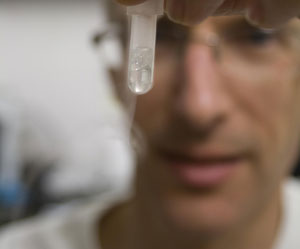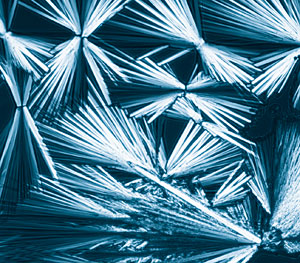
IR spectra of mosquitoes are analysed with machine learning to determine mosquito traits in order to fight malaria (bioRxiv 414342 (2018))
Lord Kelvin
David Turton examining phase transitions in a biological model system
Research in the group
The group started as an ultrafast (femtosecond) spectroscopy group, concentrating on terahertz spectroscopy (using terahertz time-domain spectroscopy, THz-TDS, but most importantly optical Kerr-effect (OKE) spectroscopy on a nanosecond to femtosecond timescale) of condensed matter: liquids, solutions, and biomolecular systems. An interest in the weird thermodynamic properties of liquid water, gradually shifted the focus of our research to supercooling (and the glass transition), phase transitions (including the purported liquid-liquid transition in water and other molecular liquids), and nucleation (of new phases including crystals). The experiments now range from femtoseconds (using OKE) to kiloseconds (using various forms of microscopy) spanning 17 orders of magnitude of time.
Phonon-like behaviour in liquids
Optical Kerr-effect (OKE) spectroscopy measures the anisotropic Raman spectrum through a time-domain technique. In our case, we can measure Raman spectra from ~250 MHz to 10-20 THz, covering orientational and translational relaxations, cage rattling, librations, and vibrations. Back in 2009, we figured out that parts of these complicated spectra can be "switched off" by choosing molecules with a high degree of symmetry. We have employed this idea on a range of liquids of interest to discover new phenomena or to pin down old but elusive phenomena. In our most recent work, we are using this idea to properly characterise the Boson peak (associated with the glass transition) for the first time providing novel insight into the reasons why & how some liquids vitrify rather than crystallise.
See press release Scientists open window on the physics of glass formation
- M. González-Jiménez, T. Barnard, B.A. Russell, N.V. Tukachev, U. Javornik, L. Hayes, A.J. Farrell, S. Guinane, H.M. Senn, A.J. Smith, M. Wilding, G. Mali, M. Nakano, Y. Miyazaki, P. McMillan, G.C. Sosso, K. Wynne, ‘Understanding the emergence of the boson peak in molecular glasses’, Nat. Commun. 14, 215 (2023). (https://doi.org/10.1038/s41467-023-35878-6)
- Reichenbach, S.A. Ruddell, M. González-Jiménez, J. Lemes, D.A. Turton, D.J. France, and K. Wynne, “Phonon-like hydrogen-bond modes in protic ionic liquids”, JACS 139, 7160-7163 (2017). (http://dx.doi.org/10.1021/jacs.7b03036)
- A. Turton, K. Wynne, ‘Universal non-exponential relaxation: complex dynamics in simple liquids’, J. Chem. Phys. Communication 131, 201101 (2009). (http://dx.doi.org/10.1063/1.3265862)
- A. Turton, J. Hunger, A. Stoppa, G. Hefter, A. Thoman, M. Walther, R. Buchner, and K. Wynne, ‘Dynamics of Imidazolium Ionic Liquids from a Combined Dielectric Relaxation and Optical Kerr Effect Study: Evidence for Mesoscopic Aggregation’, J. Am. Chem. Soc. 131, 11140-11146 (2009). (http://dx.doi.org/10.1021/ja903315v)
- A. Turton, K. Wynne, ‘Universal non-exponential relaxation: complex dynamics in simple liquids’, J. Chem. Phys. Communication 131, 201101 (2009). (http://dx.doi.org/10.1063/1.3265862)
Delocalised modes in biomolecules
As kT at room temperature is ~7THz, terahertz frequency modes play a key role in the thermodynamics and kinetics of biomolecules. While aqueous samples are opaque to terahertz radiation, the optical Kerr-effect (OKE) is ideal for measuring the terahertz spectra of biomolecules in solution. Our work has shown that biomolecules only have a small number of modes around a few THz that are highly delocalised. Proteins such as lysozyme, when kicked by a laser pulse, jiggle much like jelly. However, DNA and especially DNA folds known as G-quadruplexes, go through multiple oscillation cycles of delocalised phonon-like modes.
- M. González Jiménez, G. Ramakrishnan, N.V. Tukachev, H.M. Senn, and K. Wynne, ‘Low-frequency delocalised vibrational modes in G-quadruplexes: the mechanical properties of nucleic acids’, PCCP 23, 13250 (2021). (https://doi.org/10.1039/D0CP05404F)
- Ramakrishnan, M. González-Jiménez, A.J. Lapthorn, and K. Wynne, “Spectrum of slow and super-slow (picosecond to nanosecond) water dynamics around organic and biological solutes”, J. Phys. Chem. Lett. 8, 2964-2970 (2017). (http://dx.doi.org/10.1021/acs.jpclett.7b01127)
- Hithell, M. González-Jiménez, G.M. Greetham, P.M. Donaldson, M. Towrie, A.W. Parker, G.A. Burley, K. Wynne, N.T. Hunt, “Ultrafast 2D-IR and Optical Kerr Effect Spectroscopy Reveal the Impact of Duplex Melting on the Structural Dynamics of DNA”, PCCP 19, 10333 (2017). (http://dx.doi.org/10.1039/C7CP00054E)
- González-Jiménez, G. Ramakrishnan, T. Harwood, A.J. Lapthorn, S.M. Kelly, E.M. Ellis, and K. Wynne, “Observation of coherent delocalised phonon-like modes in DNA under physiological conditions”, Nature Commun., 7, 11799 (2016). (http://dx.doi.org/10.1038/ncomms11799)
- A. Turton, H.M. Senn, T. Harwood, A.J. Lapthorn, E.M. Ellis, and K. Wynne, ‘Terahertz underdamped vibrational motion governs protein-ligand binding in solution’, Nature Commun. 5, 3999 (2014). (http://dx.doi.org/10.1038/ncomms4999)
Liquid-liquid transitions in molecular liquids
In 1998, it was suggested that the strange thermodynamic properties of water could be explained by the existence of a liquid-liquid transition at ~220K between two amorphous but distinct forms of water. Such transitions were also predicted for other molecular liquids but only observed in water, triphenyl phosphite, n-butanol, and D-mannitol. Our latest work (2020) has shown that the liquid-liquid transition in triphenyl phosphite is caused by the competition between liquid structures that mirror two crystal polymorphs. This causes a transition between a geometrically frustrated liquid to a dynamically frustrated glass, a phenomenon that appears to be able to explain a large number of liquid-liquid and polyamorphic transitions. This idea has already allowed us to discover a new liquid-liquid transition in another molecular liquid (work in progress).
- F. Walton, J. Bolling, A. Farrell, J. MacEwen, C. Syme, M. González Jiménez, H. Senn, C. Wilson, G. Cinque, and K. Wynne, ‘Polyamorphism mirrors polymorphism in the liquid–liquid transition of a molecular liquid’, J. Am. Chem. Soc. 142, 7591-7597 (2020). https://doi.org/10.1021/jacs.0c01712)
- D. Syme, J. Mosses, M. González Jiménez, Finlay Walton, and K. Wynne, “Frustration of crystallisation by a liquid–crystal phase”, Sci. Rep. 7, 42439 (2017). (http://dx.doi.org/10.1038/srep42439)
- Mosses, C.D. Syme, and K. Wynne, ‘The order parameter of liquid-liquid phase transitions’, J. Phys. Chem. Lett., 6, 38-43 (2015). (http://dx.doi.org/10.1021/jz5022763)
Optical-tweezing induced nucleation
In 1996, it was shown that lasers can induce the nucleation of crystals and, even better, control the polymorph that crystallises. Although repeated by a number of groups, the origin of the effect remained mysterious. In recent work, we have shown that optical tweezing can be used to phase separate two liquids near their liquid-liquid critical point. We believe that this is the basis of non-photochemical laser-induced nucleation (NPLIN) and refer to it as laser-induced phase separation and nucleation (LIPSaN). Funded by an ERC Advanced Grant, we are currently investigating LIPSaN in the nucleation of small-molecule crystals, peptides, and proteins.
- Z. Liao, K. Wynne, ‘Mesoscopic amorphous particles rather than oligomeric molecular aggregates are the cause of laser-induced crystal nucleation’, Proc. Natl. Acad. Sci. USA 119, e2207173119 (2022). (https://doi.org/10.1073/pnas.2207173119)
- Z. Liao, K. Wynne, ‘A metastable amorphous intermediate is responsible for laser-induced nucleation of glycine’, J. Am. Chem. Soc. 144, 6727-6733 (2022). (https://doi.org/10.1021/jacs.1c11154)
- Walton, K. Wynne, ‘Using optical tweezing to control phase separation and nucleation near a liquid–liquid critical point’, Soft Mater 15, 8279-8289 (2019). (https://dx.doi.org/10.1039/C9SM01297D)
- Walton, K. Wynne, “Control over phase separation and nucleation using a laser-tweezing potential”, Nature Chemistry 10, 506-510 (2018) (http://doi.org/10.1038/s41557-018-0009-8)
- Mosses, D.A. Turton, L. Lue, J. Sefcik, and K. Wynne, ‘Crystal templating through liquid–liquid phase separation’, Chem. Commun. 51, 1139-1142 (2015). (http://dx.doi.org/10.1039/c4cc07880b)
- Reichenbach and K. Wynne, ‘Frustration vs. Prenucleation: Understanding the Surprising Stability of Supersaturated Sodium Thiosulfate Solutions’, J. Phys. Chem. B. 122, 7590-7596 (2018). (http://doi.org/10.1021/acs.jpcb.8b04112)
Mosquitoe spectroscopy
- D.J. Siria, R. Sanou, J. Mitton, E.P. Mwanga, A. Niang, I. Sare, P.C.D. Johnson, G.M. Foster, A.M.G. Belem, K. Wynne, R. Murray-Smith, H.M. Ferguson, M. González-Jiménez, S.A. Babayan, A. Diabaté, F.O. Okumu and F. Baldini, ‘Rapid age-grading and species identification of natural mosquitoes for malaria surveillance’, Nat. Commun. 13, 1501 (2022). (https://doi.org/10.1038/s41467-022-28980-8)
- M. González-Jiménez, S.A. Babayan, P. Khazaeli, M. Doyle, F. Walton, E. Reedy, T. Glew, M. Viana, L. Ranford-Cartwright, A. Niang, D.J. Siria, F.O. Okumu, A. Diabaté, H.M. Ferguson, F. Baldini, and K. Wynne, ‘Prediction of malaria mosquito species and population age structure using mid-infrared spectroscopy and supervised machine learning’, bioRxiv 414342 (2018). (http://doi.org/10.1101/414342) Wellcome Open Res. 4, 76 (2019). (https://doi.org/10.12688/wellcomeopenres.15201.3)
Old research section (will clean up soon-ish...)
Some recent projects:
- Un-mixing using lasers to make new crystals (2018)
- The Mayonnaise Effect (2017)
- Phonon-like hydrogen-bond modes in protic ionic liquids (2017)
- Frustrating liquid crystals (2017) including a video
- Sound-like bubbles whizzing around in DNA are essential to life (2016)
- Proteins 'ring like bells': ultrafast OKE spectroscopy on an enzyme in solution (2014)
- The role of liquid-liquid demixing in crystallisation: icy fluff balls (2015)
- Room-temperature ionic liquids
- Serving nanoparticle "soup" (2009)
Our work is carried out in collaboration with various other groups such as (most recently):
- Dr. Gabriele Sosso (Warwick), Prof. Paul McMillan and Dr. Martin Wilding (UCL), Prof. Gregor Mali (National Institute of Chemistry, Ljubljana, Slovenia), Prof. Motohiro Nakano, Prof. Yuji Miyazaki (Osaka University) – properties and simulations of supercooled and vitrified liquids.
- Prof. Heather Ferguson, Dr Francesco Baldini, Dr Simon Babayan, and Dr Lisa Ranford-Cartwright (Institute of Biodiversity Animal Health and Comparative Medicine, GU), Prof Richard Hogg and Dr David Childs (School of Engineering, GU), Prof. Roderick Murray-Smith (Computing Science, GU), Prof Hilary Ranson (Dept. of Vector Biology, U. Liverpool), Dr Abdoulaye Diabaté (Institut de Recherche en Sciences de la Santé, Burkina Faso), Dr Fredros O. Okumu (Ifakara Health Institute, Tanzania) – spectroscopy and machine learning of mosquitoes.
- Prof. Neil Hunt (University of York, Physics), Dr Glenn Burley (SU, Chemistry), Dr Gregory Greetham, Dr Paul Donaldson, Michael Towrie, Anthony Parker (STFC Central Laser Facility) – DNA dynamics.
Some groupings we are part of:
- Our "super" group is the Chemical Photonics group
- We have set up the Ultrafast Chemical Physics inScotland grouping to promote femtosecond spectroscopy. We also have organised a couple of UCP meetings.
 In 2015, we have set up the Biomolecular spectroscopy and dynamics Cluster as a centre of excellence in biospectroscopy in Scotland.
In 2015, we have set up the Biomolecular spectroscopy and dynamics Cluster as a centre of excellence in biospectroscopy in Scotland.- Member of the Directed Assembly Network (An EPSRC Grand Challenges Network)
Some older research pages:


















